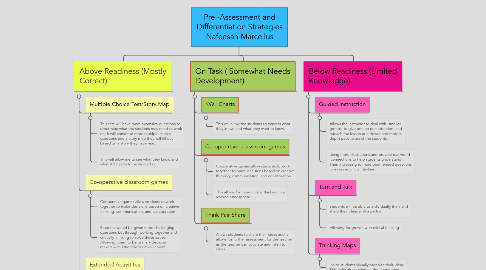
1. Above Readiness (Mostly Correct)
1.1. Multiple Choice Test/Story Map
1.1.1. This test will have more extensive questions to determine what the students may need to work on. It will consist of more multiple choice questions and a story map they will fill out based on a story they have read
1.1.2. This will allow me to see what they know and what still needs to be worked on.
1.2. Co-operative classroom games
1.2.1. Cooperative games allow students to work together to make decisions based on creative thinking, communication, and collaboration
1.2.2. Students would be given more challenging questions but through working together and critically thinking to solve these issues. Allowing them to be primary decision makers with little teacher involvement.
1.3. Extended Activitites
1.3.1. Students can be asked more open ended questions to challenge them.
1.3.2. They can create their own stories and include through illustration and sentences all of the elements of the story.
2. On Task ( Somewhat Needs Development)
2.1. KWL Charts
2.1.1. This will allow the students to express what they know, and what they want to know.
2.2. Co-operative classroom games
2.2.1. Cooperative games allow students to work together to make decisions based on creative thinking, communication, and collaboration.
2.2.2. This allows for more critical thinking in a relaxed atmosphere.
2.3. Think Pair Share
2.3.1. Allows students to share their ideas and it allows for further assessment for the teacher as the teacher can circulate and listen to ideas.
3. Below Readiness (Limited Knowledge)
3.1. Guided instruction
3.1.1. Allows the instructor to deal with smaller groups to give one on one attention, and reteach the lesson at a slower and more in depth pace to assist the students.
3.1.2. Using more illustrations and provide real world connections to help students understand. Then increasing to more open ended questions to increase critical thinking.
3.2. Turn and Talk
3.2.1. Students will be able to individually think and share their ideas with a partner.
3.2.2. Allowing for growth with critical thinking
3.3. Thinking Maps
3.3.1. Helps students visually organize their ideas. This helps them connect the information.
